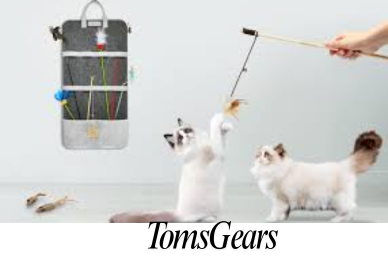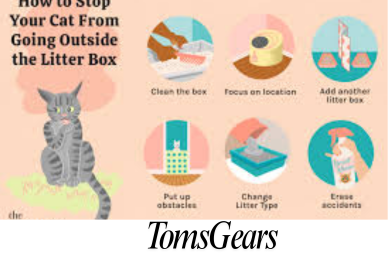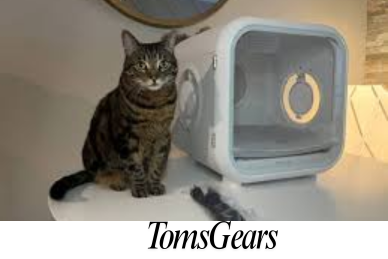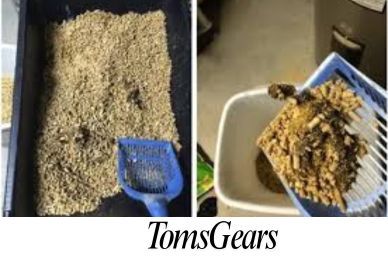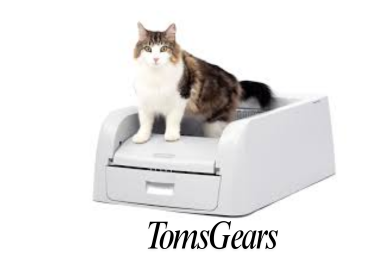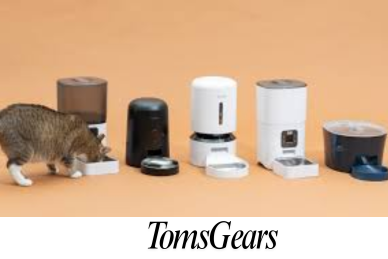30 Strange Cat Behaviors and Why Do They Do Those
Communication Behaviors
- Purring
Purring is perhaps the most recognizable cat sound, often associated with contentment. However, this soothing vibration serves multiple purposes. Cats purr not only when they’re happy but also when stressed, in pain, or even to promote self-healing.
Interestingly, the frequency range of a cat’s purr (25-150 Hz) has been suggested to have therapeutic effects. Some studies indicate that these vibrations may aid in tissue regeneration and bone healing. This could explain why cats often purr when injured or recovering from illness.
Cats can produce various types of purrs, including:
- Soft, continuous purrs: Usually indicating contentment
- Rumbling purrs: Often heard during feeding time or when seeking attention
- Chirping purrs: Sometimes made when greeting other cats or humans
- Meowing
Unlike popular belief, adult cats rarely meow at each other. Meowing is primarily a behavior cats have developed to communicate with humans. Kittens meow to their mothers, but as they grow, they typically reserve this vocalization for their human companions.
Different meows can signify various needs:
- Short meows: Generally a greeting
- Multiple meows: Excited greetings
- Mid-pitch meows: Requests for food or attention
- Low-pitch meows: Often complaints or expressions of discomfort
- High-pitch meows: Usually indicating pain or distress
As cats age, they may become more vocal. Senior cats sometimes meow more due to cognitive changes or increased need for attention.
- Hissing and Growling
When a cat hisses or growls, it’s clearly communicating discomfort, fear, or aggression. These vocalizations are usually accompanied by specific body language:
- Flattened ears
- Arched back
- Puffed up fur
- Dilated pupils
- Twitching or swishing tail
If you encounter a hissing or growling cat, it’s best to give them space. To de-escalate the situation:
- Slowly back away
- Avoid direct eye contact
- Speak in a soft, calm voice
- Provide an escape route for the cat
4. Tail Talk
A cat’s tail is a remarkably expressive appendage, capable of conveying a wide range of emotions and intentions.
Image: cat tail positions and meanings chart
Here’s a brief guide to tail positions and their meanings:
- Tail high and straight: Confidence, friendliness
- Tail curved like a question mark: Playful, approachable
- Tail low and swishing: Agitation, potential aggression
- Tail puffed up: Fear or aggression
- Tail wrapped around another cat or person: Affection
It’s important to note that tail communication can vary slightly between breeds and individual cats. Always consider the entire body language and context when interpreting your cat’s tail signals.
Social Behaviors
5. Head-butting or Bunting
When your cat gently bumps its head against you, it’s engaging in a behavior called bunting. This affectionate gesture serves two purposes:
- Showing trust and affection
- Marking you with their scent
Cats have scent glands located on their faces, particularly on their cheeks, chin, and forehead. By rubbing these areas against you, they’re depositing their scent, effectively claiming you as part of their territory.
Bunting is also observed between cats in social groups, reinforcing bonds and establishing a communal scent profile.
6. The Slow Blink
Often referred to as a “cat kiss,” the slow blink is a powerful form of cat-to-human communication. When a cat looks at you and slowly closes and opens its eyes, it’s signaling trust and affection.
You can reciprocate this gesture by slowly blinking back at your cat. This simple act can help strengthen your bond and make your cat feel more comfortable in your presence.
7. Face Rubbing
Similar to head-butting, face rubbing is another way cats mark their territory and show affection. When a cat rubs its face against objects in your home, it’s leaving its scent behind, creating a familiar and comforting environment.
When your cat rubs its face against you, it’s not only marking you but also showing trust and affection. This behavior is often more pronounced when you return home after being away, as your cat refreshes its scent on you.
Bonus Behavior: Allogrooming
Allogrooming, or social grooming between cats, is a behavior that strengthens social bonds. Cats groom each other in areas that are hard to reach, like the head and neck. This behavior not only serves a practical purpose but also reinforces social hierarchies and familial connections within a group of cats.
In multi-cat households, observing allogrooming can provide insights into the social dynamics between your feline companions.

Hunting and Play Behaviors
8. Pouncing and Chasing
Even well-fed house cats retain their hunting instincts. Pouncing and chasing behaviors are manifestations of these innate predatory drives. These actions help cats stay physically and mentally sharp.
For indoor cats, it’s crucial to provide outlets for these behaviors. Interactive toys that mimic prey movement, such as feather wands or robotic mice, can help satisfy their hunting instincts. Regular play sessions not only provide exercise but also strengthen the bond between you and your cat.
9. Chattering at Birds
Many cat owners have observed their feline friends making a distinctive chattering sound while watching birds through a window. This behavior, characterized by a rapid jaw movement accompanied by a series of chirps or clicks, has several theories behind it:
- Predatory excitement: The sound may express frustration at not being able to reach the prey.
- Hunting strategy: Some researchers suggest it might be an attempt to mimic bird or rodent sounds to lure prey closer.
- Instinctive response: The chattering might be linked to the “killing bite” reflex, a rapid neck movement used to break prey’s neck.
While the exact reason remains debated, this behavior is a fascinating glimpse into your cat’s predatory nature.

10. Bringing “Gifts
Finding a dead mouse or bird on your doorstep might not be your idea of a great gift, but for your cat, it’s a significant gesture. This behavior stems from a cat’s instinct to provide for their family or teach hunting skills.
In the wild, mother cats bring prey to their kittens to teach them how to hunt and eat. Your well-fed house cat might be trying to “feed” you or teach you these important skills.
To manage this behavior:
- Keep your cat indoors to prevent hunting of local wildlife.
- Provide plenty of interactive play to satisfy hunting instincts.
- Use puzzle feeders to simulate the challenge of “hunting” for food.
11. Kneading or “Making Biscuits”
The rhythmic pushing of paws against a soft surface, often accompanied by purring, is known as kneading. This behavior originates in kittenhood when kittens knead their mother’s belly to stimulate milk flow.
In adult cats, kneading can indicate:
- Contentment and relaxation
- A way to mark territory through scent glands in their paws
- Preparation for rest, as wild cats might knead tall grass to create a soft sleeping spot
If your cat kneads on you, it’s a sign of trust and affection. However, if their claws cause discomfort, gently place a soft blanket between you and your cat to protect your skin.
Bonus: Sudden Bursts of Energy or “Zoomies”
Those moments when your cat suddenly tears through the house at top speed, often late at night, are affectionately known as the “zoomies.” This behavior, technically called Frenetic Random Activity Periods (FRAPs), is normal and serves several purposes:
- Releasing pent-up energy, especially in indoor cats
- Mimicking the short bursts of activity wild cats use for hunting
- Expressing excitement or happiness
To manage zoomies:
- Engage in regular play sessions, especially before bedtime.
- Provide vertical spaces and cat trees for safe running and climbing.
- Create a stimulating environment with toys and scratching posts.
Environmental Interactions
12. Sitting in Boxes or Small Spaces
A cat’s affinity for boxes and small spaces is rooted in their instinct for safety and security. In the wild, enclosed spaces offer protection from predators and a vantage point for observing surroundings.
Benefits of box-sitting for cats include:
- Stress reduction
- Temperature regulation (boxes provide insulation)
- A sense of control over their environment
To cater to this preference, provide your cat with various “hiding” spots like boxes, cat caves, or cozy beds with high sides.

13. Hiding in High Places
Cats are natural climbers and often seek out high perches. This behavior serves several purposes:
- Provides a sense of security and control
- Allows for better observation of their territory
- Offers an escape from ground-level stressors (like other pets or children)
Creating vertical spaces in your home can greatly enrich your cat’s environment. Consider installing cat shelves, tall scratching posts, or cat trees to satisfy this natural inclination.
14. Scratching Furniture
While frustrating for owners, scratching is a natural and necessary behavior for cats. It serves multiple purposes:
- Removes old claw sheaths, keeping claws healthy
- Marks territory through scent glands in paws
- Provides a satisfying stretch for muscles
To protect your furniture while meeting your cat’s needs:
- Provide appropriate scratching surfaces (posts, boards) with various textures
- Place scratching items near favorite scratching spots
- Use positive reinforcement to encourage use of designated scratching areas
- Consider nail caps or regular trimming as humane alternatives to declawing

15. Toilet Paper Unrolling
The sight of shredded toilet paper strewn across the bathroom floor is familiar to many cat owners. This behavior is driven by a cat’s attraction to movement and texture. The unrolling motion triggers their play instinct, while the soft texture appeals to their sensory preferences.
To prevent toilet paper destruction:
- Store rolls in a closed cabinet
- Use a toilet paper cover
- Place the roll with the paper hanging from the back, making it harder to unroll
- Provide alternative toys with similar textures or movement

Bonus Behavior: Paper and Plastic Bag Fascination
Many cats are inexplicably drawn to paper and plastic bags. The crinkly sound, coupled with the novelty of a new object in their territory, makes these items irresistible to many felines.
While this behavior is generally harmless, supervise your cat around plastic bags to prevent suffocation risks. Paper bags (with handles removed) can make for safe and entertaining cat toys.
Sleeping and Resting Behaviors
16. Sleeping in Unusual Positions
Cats are known for their ability to sleep in seemingly uncomfortable positions. This flexibility allows them to:
- Adapt to various sleeping surfaces
- Regulate body temperature
- Stay alert to potential threats
Common cat sleeping positions include:
- The loaf: Paws tucked under, resembling a loaf of bread
- The contortionist: Twisted in seemingly impossible shapes
- The belly-up: A sign of complete relaxation and trust
Cats spend about 15 hours a day sleeping, with older cats sleeping even more. Their sleep cycles include short periods of deep sleep followed by longer periods of light sleep, allowing them to remain alert to their surroundings.
17. Showing Their Belly: A Gesture of Trust
When a cat exposes its belly, it’s displaying a significant amount of trust. The belly is a vulnerable area, and showing it indicates that the cat feels safe and comfortable in its environment.
However, this doesn’t necessarily mean the cat wants a belly rub. Many cats may react defensively if you touch their exposed belly. Instead, appreciate the trust your cat is showing and respond with gentle pets on the head or chin if they seem receptive.

Bonus: Sunbathing
Cats are drawn to warm, sunny spots for several reasons:
- Heat regulation: Cats have a higher body temperature than humans and seek out warmth
- Vitamin D synthesis: Sunlight helps cats produce vitamin D, essential for bone health
- Relaxation: Warmth promotes relaxation and comfort
While sunbathing is generally beneficial, ensure your cat has access to shade and fresh water to prevent overheating. For indoor cats, consider creating a sunny spot near a window with a comfortable perch.
Water-Related Behaviors
18. Drinking from Unusual Water Sources
Many cat owners notice their pets eschewing their water bowl in favor of dripping faucets, toilet bowls, or even outdoor puddles. This preference for moving water is thought to be an instinctual behavior:
- In the wild, moving water is often fresher and safer than stagnant water
- The movement and sound of running water may be more attractive to cats
To encourage proper hydration:
- Use a cat water fountain to provide moving water
- Place water bowls away from food bowls (cats naturally prefer to drink away from their food source)
- Use wide, shallow bowls that don’t interfere with whiskers
19. Playing with Water
While many cats avoid getting wet, some show a fascination with running water. This behavior might be linked to:
- Curiosity about the movement and reflection of water
- The challenge of “catching” the water
- A preference for fresh, moving water for drinking
If your cat enjoys water play, you can encourage safe interaction by:
- Providing a shallow water dish for paw-dipping
- Using water fountains with cascading water features
- Supervising play with a slowly running faucet

Eating and Dietary Behaviors
20. Eating Non-Food Items (Pica)
Pica, the consumption of non-food items, can be concerning in cats. Common targets include:
- Fabric
- Plastic
- Plants
- String or yarn
Potential causes of pica include:
- Nutritional deficiencies
- Stress or anxiety
- Medical issues like gastrointestinal problems
- Boredom or lack of environmental enrichment
If you notice your cat regularly eating non-food items, consult with a veterinarian to rule out medical causes and develop a management plan.

21. Grass Eating
Many cats occasionally nibble on grass, a behavior that puzzles many owners. Theories behind grass eating include:
- Aiding digestion or inducing vomiting to clear hairballs
- Providing additional fiber
- Fulfilling a nutritional need for folic acid
While occasional grass eating is normal, be cautious of outdoor plants that may be toxic. Provide safe alternatives like cat grass for indoor cats.
22. Food Covering or “Burying”
Some cats appear to “bury” their food by pawing at the floor around their bowl. This instinctual behavior stems from wild cats’ habit of hiding leftover prey to prevent scavenging by other animals.
In domestic settings, food covering might indicate:
- The cat is saving the food for later
- Dissatisfaction with the food or its placement
- An attempt to hide the scent of the food
If this behavior becomes problematic, try feeding smaller portions more frequently or changing the location of the food bowl.
Grooming and Hygiene
23. Over-Grooming
While cats are known for their meticulous grooming habits, excessive grooming can be a sign of underlying issues. Over-grooming may lead to hair loss, skin irritation, or even open sores.
Potential causes of over-grooming include:
- Stress or anxiety
- Allergies (food or environmental)
- Skin conditions or parasites
- Boredom or compulsive behavior
Signs that grooming has become problematic:
- Bald patches or thinning fur
- Skin redness or irritation
- Spending excessive time grooming one area
- Aggressive reaction when interrupted during grooming
If you notice these signs, consult with a veterinarian to identify the underlying cause and develop a treatment plan. This may include addressing environmental stressors, changing diet, or in some cases, medication.

24. Hairballs
Hairballs are a common issue for many cat owners. As cats groom themselves, they ingest loose fur, which can accumulate in the stomach and form hairballs. While occasional hairballs are normal, frequent hairballs may indicate an issue.
To help prevent hairballs:
- Brush your cat regularly to remove loose fur
- Provide a high-fiber diet to help move hair through the digestive system
- Consider hairball-specific cat foods or treats
- Use pet-safe lubricants or gels designed to help pass hairballs
If your cat is frequently producing hairballs or showing signs of distress, consult with a veterinarian, as excessive hairballs can sometimes indicate underlying digestive issues.
Nighttime and Sensory Behaviors
25. Meowing at Night
Increased vocalization at night can be frustrating for cat owners. This behavior can stem from various causes:
- Natural nocturnal tendencies (cats are crepuscular, most active at dawn and dusk)
- Hunger or thirst
- Need for attention
- Medical issues, especially in older cats
- Cognitive dysfunction in senior cats
To manage nighttime meowing:
- Establish a consistent feeding schedule, including a meal before bedtime
- Engage in interactive play sessions in the evening to tire out your cat
- Provide environmental enrichment to keep your cat occupied
- Ignore attention-seeking meows to avoid reinforcing the behavior
- Consult a vet if the behavior is new or accompanied by other symptoms
26. Staring Contests
Cats use eye contact as a form of communication, but the meaning can vary depending on the context:
- Slow blinking: A sign of affection and trust
- Wide eyes with dilated pupils: Excitement or fear
- Narrow eyes with constricted pupils: Aggression or irritation
When a cat stares at you, it might be:
- Seeking attention or food
- Showing affection
- Asserting dominance
- Feeling threatened (if accompanied by other aggressive body language)
Always consider the entire body language when interpreting a cat’s stare. Avoid staring back at an unfamiliar or agitated cat, as this can be perceived as a threat.

27. Whisker Twitching
A cat’s whiskers are highly sensitive sensory organs that help them navigate their environment. Whisker movements can indicate a cat’s emotional state:
- Forward-pointing whiskers: Interest or alertness
- Pulled-back whiskers: Fear or aggression
- Relaxed whiskers: Calm and content
- Twitching whiskers: Excitement or sensory stimulation
Whisker fatigue is a condition where a cat’s whiskers become overstimulated, often from repeatedly brushing against the sides of a narrow food or water bowl. To prevent this, use wide, shallow bowls for feeding and drinking.
28. The Flehmen Response
The Flehmen response, often mistaken for a snarl, is a behavior where a cat appears to grimace with an open mouth. This action allows scents to reach the vomeronasal organ (also known as Jacobson’s organ) located in the roof of the mouth.
Common triggers for the Flehmen response include:
- Investigating urine marks
- Smelling pheromones from other cats
- Encountering new or strong odors
This behavior helps cats gather more information about their environment and other animals, playing a crucial role in social and territorial behavior.
Stress-Related Behaviors
29. Excessive Vocalization
While some cats are naturally more vocal than others, a sudden increase in meowing can indicate an underlying issue:
- Medical problems: Pain, thyroid issues, or cognitive dysfunction in older cats
- Stress or anxiety: Changes in environment or routine
- Attention-seeking behavior
- Hunger or thirst
To address excessive vocalization:
- Rule out medical causes with a veterinary check-up
- Identify and address potential stressors in the environment
- Establish a consistent routine for feeding and playtime
- Provide environmental enrichment to reduce boredom
- Use positive reinforcement to reward quiet behavior
30. Inappropriate Elimination
Urinating or defecating outside the litter box is a common problem that can have various causes:
Medical reasons:
- Urinary tract infections
- Bladder stones
- Kidney disease
- Arthritis (making it difficult to enter the litter box)
Behavioral reasons:
- Stress or anxiety
- Litter box aversion (due to cleanliness, location, or type of litter)
- Territorial marking
- Changes in the household (new pets, moving, etc.)
To address inappropriate elimination:
- Consult a veterinarian to rule out medical issues
- Ensure the litter box is clean and easily accessible
- Provide multiple litter boxes in multi-cat households
- Experiment with different types of litter
- Address potential stressors in the environment
- Use enzymatic cleaners to thoroughly clean soiled areas
Wrapping Up
Understanding your cat’s behavior is key to fostering a strong, positive relationship with your feline friend. While we’ve explored 20 strange cat behaviors, it’s important to remember that each cat is an individual with its own unique personality and quirks. Remember, if you notice sudden changes in your cat’s behavior or are concerned about any particular behaviors, it’s always best to consult with a veterinarian.
Key takeaways:
- Many “strange” behaviors are normal for cats and serve important purposes
- Understanding cat body language and vocalizations improves communication
- Environmental enrichment is crucial for a cat’s physical and mental well-being
- Regular veterinary check-ups can help catch and address potential issues early
By embracing and working with your cat’s natural instincts and behaviors, you can create a harmonious household that meets both your needs and those of your feline companion.

